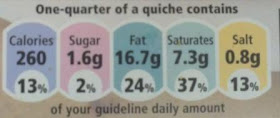 Much of the packaging on the food we buy these days provides useful information for health conscious consumers. This usually includes nutritional details such as the amount of fat, sugar, salt and number of calories in the product. Many also provide a serving size or a portion size.
Much of the packaging on the food we buy these days provides useful information for health conscious consumers. This usually includes nutritional details such as the amount of fat, sugar, salt and number of calories in the product. Many also provide a serving size or a portion size.However, this is where consumers can often become misled, since portion sizes and serving sizes are not one and the same. So what’s the difference?
What is a Serving Size?
As a general guide, a serving size is a measured amount of food as recommended on the packet. For example, a packet of breakfast cereal may state ‘this packet provides enough for 15 x 30g servings’. Or a ready meal may state it ‘serves two’. So a serving is a fixed amount of food, like a slice of bread, a cup of milk, or two heaped tablespoons of cooked pasta.
What is a Portion Size?
A portion size, on the other hand, is a variable amount. When examining the label, it may state the number of servings in the product, and each of those servings is one portion. When eating out, some restaurants may serve portions which are large enough to serve two people. Eating portion sizes which are too large on a regular basis can lead to weight gain, more so when the portions include high fat or high sugar food.This is easily done when eating a packet of crisps, for example as some of the larger packs are meant to be shared but often they end up being eaten by one person.
Understanding the Label
Labels can be misleading. Most labels show nutritional information per 100g, while some provide extra breakdowns per serving size or for the entire pack. For example, a label may state it has 250 calories per serving. If the product holds enough for two servings and weighs 500g, there will be 500 calories in the entire product. People can mistakenly think the figure on the front (250 calories per serving) is for the entire pack. Unless you scrutinize the small print to find out exactly how big that serving size is, you can end up eating far more than you intended.
This is why people often come unstuck when dieting, as they are getting their portions sizes wrong. And unfortunately, the terms ‘servings size’ and ‘portion size’ are often used interchangeably which can make it all the more confusing.
Typical Labels
Here is a look at some examples of nutritional labels which are commonly found on pre-packed food.
The label of this 450 yogurt pot clearly shows that a serving size is 150g. Since the pot holds 450g, you need to work out for yourself that the entire pot holds 3 individual servings. It does helpfully provide the nutritional information for each serving size as well as per 100g.
This is a typical label found on the side of cereal boxes. It states that this box holds 12 x 40g servings. So if you only managed to extract 8 bowls of cereal from the box, your portion sizes are too large.
The label on this packet of frozen vegetables indicates the number of calories per 100g and has the recommended portion size as 80g when cooked. Since it’s a frozen product, you’d need to weigh it after cooking. In the case of these vegetables, calories are so low it would hardly make a difference.
This label is from the side of a 400g pot of fruit. It recommends a serving size is 125g. However, the pot only holds enough for 3.2 servings, so it's likely you'll get three different sized portions.
The label on this packet of pasta sauce is very clear. The packet holds one serving and the nutritional information on the front is for the entire packet. In small print below it also states that this packet provides one portion.
This label provides a slightly different approach. By stating that one-quarter of this quiche contains 260 calories, it is recommending that one portion should equal a quarter of the quiche, thereby providing enough for 4 servings.
This label is from the front of a 450g ready meal. It doesn't state the number of servings it contains, so you might assume it was for one. You could however, divide it into two portions for a lower calorie meal.
This packet of microwavable rice shows the breakdown for each serving size of 125g. Since the packet contains 250g, there are two servings of rice. The front also clearly shows that the pack contains two servings.
This is a good example of clear labelling which is found on Tesco's Oat cereal. It clearly states that a serving equals 30g and is worth one portion.
Nutritional labels are a valuable tool for helping dieters and those with special nutritional needs, for example, diabetics or people watching their cholesterol intake. But labels can be misleading as manufacturers have many different ways of displaying their product's information. And don't forget, portion sizes are variable, whereas serving sizes are a measured amount, usually recommended by government dietary guielines.
© Diets and Calories 2011











No comments:
Post a Comment